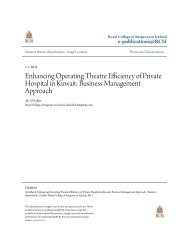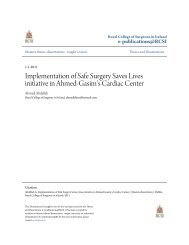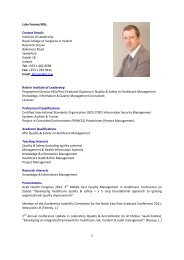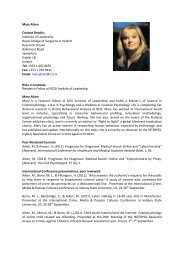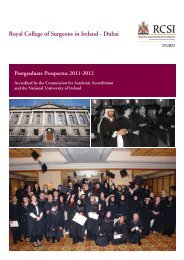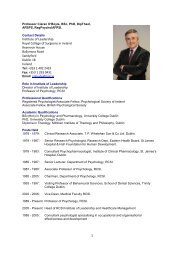Improving the Assessment and Triage of Patients with Mental Illness ...
Improving the Assessment and Triage of Patients with Mental Illness ...
Improving the Assessment and Triage of Patients with Mental Illness ...
Create successful ePaper yourself
Turn your PDF publications into a flip-book with our unique Google optimized e-Paper software.
After consideration <strong>of</strong> <strong>the</strong> aforementioned models <strong>of</strong> change, <strong>the</strong> HSE Change Model<br />
was chosen as <strong>the</strong> most appropriate model <strong>of</strong> choice. The principal reason for selecting this<br />
model was its continuous cyclical nature. The model was developed by adapting various<br />
elements <strong>of</strong> o<strong>the</strong>r models to suit its purpose (HSE, 2008). It has been developed specifically<br />
to cater for <strong>the</strong> needs <strong>and</strong> requirements for both health service providers <strong>and</strong> service users.<br />
The model was deemed particularly suitable for this project as it seeks to involve individuals<br />
<strong>and</strong> teams which is a fundamental pre-requisite for success in any change initiative. Huber<br />
(2000) suggests that staff involvement <strong>and</strong> buy-in are important to <strong>the</strong> success <strong>of</strong> any<br />
program <strong>of</strong> change. Ano<strong>the</strong>r advantage <strong>of</strong> this change model is that it was formulated by <strong>the</strong><br />
Health Service Executive. It seems not unreasonable to posit that a model that was first<br />
created for <strong>the</strong> broader Health Service Executive can be readily adapted to suit specific areas<br />
that come <strong>with</strong>in <strong>the</strong> remit <strong>of</strong> <strong>the</strong> HSE. Consequently if a change initiative is successful in<br />
one area <strong>of</strong> <strong>the</strong> executive it could be disseminated to o<strong>the</strong>r areas <strong>of</strong> <strong>the</strong> organisation <strong>with</strong><br />
relative ease.<br />
3.5 The Change Process.<br />
As outlined in <strong>the</strong> previous section <strong>the</strong> structure <strong>of</strong> <strong>the</strong> HSE (2008) Change Model<br />
was used to undertake a change management project in a busy Emergency Department. The<br />
impetus to change both behaviour <strong>and</strong> performance in <strong>the</strong> healthcare system in <strong>the</strong> current<br />
climate requires an investment <strong>of</strong> time, effort <strong>and</strong> direction to enhance <strong>the</strong> quality <strong>of</strong> service<br />
delivery. The use <strong>of</strong> a model in providing a structure to <strong>the</strong> change initiative is essential in<br />
maintaining focus <strong>and</strong> momentum for any project big or small (Muldrow et al, 2002). The<br />
change project was executed under <strong>the</strong> four key headings <strong>of</strong> <strong>the</strong> HSE Change Model (2008)<br />
as outlined in Figure 1<br />
17




